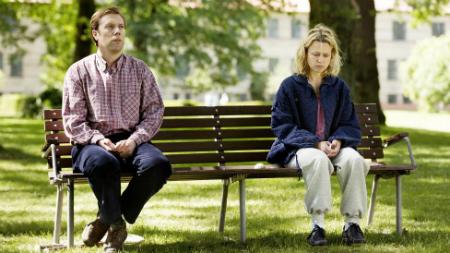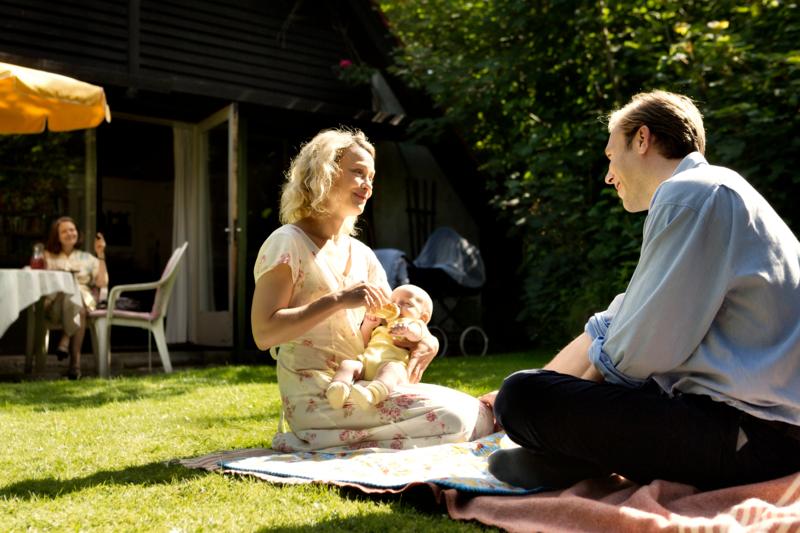"We'll manage," says the mentally unstable young mother to her film director husband. Nine months earlier she gave birth to their first child.
Fatally superficial, her husband responds: "Of course we'll manage!", as he dashes out of the door on his way to give a talk.
A few hours later the mother kills the couple's young child in a psychotic fit.
A horror story? Yes, but no more sensational than the fact that many of the narrative's countless painful details are precisely based on a tragic event in director Nils Malmros' own life. Thirty years ago he lost his daughter under the same circumstances depicted in the film, having to realise that his marriage was hanging by the slimmest thread imaginable.
Could he help the woman he loved out of darkness? Would the scars of this terrible event ever heal?
A Love Story
In "Sorrow and Joy", Danish cinema's perhaps most significant psychological realist Nils Malmros recounts a horrifying chapter in his life with great courage. Despite the magnitude of the trauma, as the years go by he can look it in the eye, and he is still married to the woman who murdered their child.
On screen, it becomes the story of a love that grows out of the anguish – a mature, responsible love as opposed to the youthful and, in most cases, unhappy love affairs that otherwise haunt Malmros' male protagonists.
MASTER OF MEMORY. Nils Malmros recaptures the details of past situations and moods in his films, including "Sorrow and Joy". Photo: Photo: Martin Dam Kristensen
Total Recall
Malmros, 69, bases his films on a technique reminiscent of total recall. As a master of memory who can recapture the details of past situations, characters, moods and everyday life with almost uncanny precision, he commands a singular position at the forefront of Danish filmmaking, admired by Lars von Trier and honoured time and again with Danish film awards.
For many years the landscape of childhood was Malmros' special territory, evoked, for example, in his witty yet sensitive major work "Tree of Knowledge" (1981), which follows a school class over several years during which we see the pupils gradually mature before our eyes.
In "Sorrow and Joy", we see glimpses of his work with this film and his next production, "Beauty and the Beast" (1983), in which the feelings of a weak-willed father towards his 16-year-old daughter become over-charged.
GROWING UP. The actors of "The Tree of Knowledge" literally mature before our eyes as Malmros shot the film over two years, following a class during its final years of grade school. Photo: Torben Stroyer
Erotic challenge
However, the film that most clearly foreshadows "Sorrow and Joy" is "Pain of Love" (1991) about a manic depressive girl who – "caught in my own web", as she says – battles vainly to conquer her disorder.
Most of Malmros' young heroines have fragile psyches and a wildly erratic emotional register, often coupled with strong erotic attraction and drive.
In counterpoint to this, in many ways childlike woman stand the alter-ego figures Malmros frequently uses, figures whom she fascinates and challenges but who themselves come across as rational and middle-class minded, with emotional and sexual inhibitions. Products of the petit-bourgeois morality and authoritarian education in the better social circles of the 1950s and early 1960s.
Modelled on real people
In his eleven feature films, Malmros has created a meticulous mosaic of his life, richly detailed with almost pedantic precision, and thus produced a work rarely matched in cinema history.
His characters are not only modelled on living people – they also physically resemble them. Malmros graduated in medicine alongside his career as a film director, and his detailed realism has an almost surgical accuracy.
Nonetheless, the spirit of a poet breathes through this panorama of Danish school life, youth and the difficulties of adolescence over the decades. Precision and poetry go hand-in-hand in a lifework where humour and gentle irony often cast a sense of perspective on human adversity.
Naturally, humour plays a smaller role in "Sorrow and Joy" than in many of Malmros' earlier productions. "Sorrow and Joy" in turn speaks more directly and immediately to the emotions than any other Malmros film.
Tragedy strikes cruelly, but also makes characters grow. For the first time in Malmros' many memoir films, they finally grow up.
"Sorrow and Joy" is written by Nils Malmros and John Mogensen, and Thomas Heinesen has produced for Nordisk Film. International sales are handled by Trustnordisk. The film enjoys its world premiere at Rome Film Festival. Domestic release is 14 November.
Rome Film Festival 8-17 November 2013
About Nils Malmros
Born 5 October 1944, Denmark. Graduate of medicine, 1988. Malmros, who found inspiration early on in the French New Wave, is considered one of Danish cinema's major auteurs. As both screenwriter and director, Malmros maintains a strong autobiographical element in his works which draw on the director's memories of growing up in the provincial town of Aarhus. His films are characterized by a unique psychological realism, often using amateur actors from the actual milieus he depicts.
Malmros' breakthrough film "Lars Ole 5c" (1973) is the first part of a trilogy on childhood and adolescence, followed by "Boys" (1977) and "The Tree of Knowledge" (1981), all considered classics in Danish cinema. The autobiographical inspiration is directly evident in "Aarhus by Night" (1989), which replays the making of "Boys". Selected for competition in Berlin were "Beauty and the Beast" (1983), "Pain of Love" (1992) and "Barbara" (1997).




